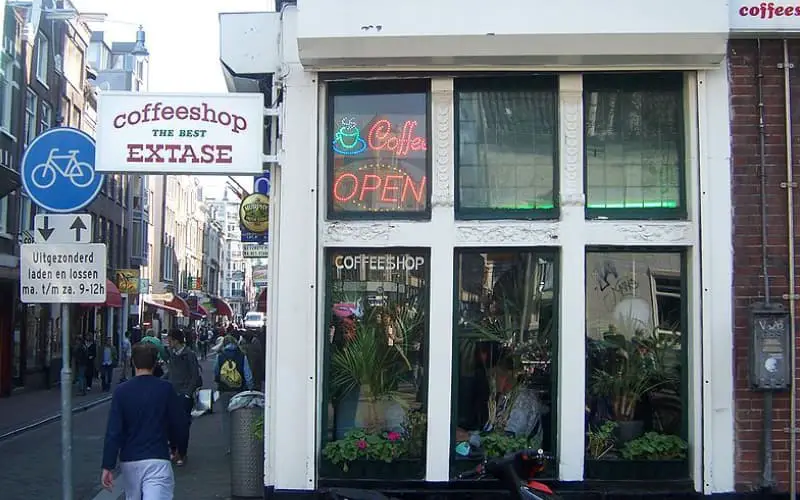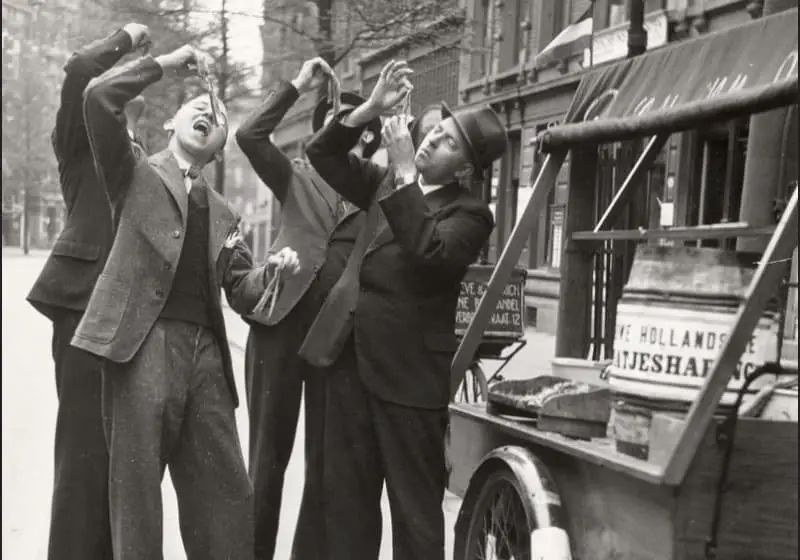

The Netherlands and America are two countries that look totally different from each other at first sight. One country has 330 million inhabitants, the other one only counts 17 million inhabitants. One country lies in Europe, the other one in North-America. I, as a Dutchman, am very curious as to how much we actually differ from Americans.
Thousands of kilometers lie between the two, and there are several cultural differences between the Netherlands and the USA. The Dutch have their own culture and social values which can certainly surprise an American during their first visit to the Netherlands.
But of course, this is also the case when a Dutch person visits America. This only makes it more interesting to find out more about the biggest differences and similarities between the Dutch culture vs American culture.
Did you know, for example, that in the Netherlands it’s custom to greet people you know and to kiss them on their cheeks three times? Weird, right?
In this blog, I will take you with me to find out what the cultural differences and similarities are between the Dutch culture vs American culture.
When a foreigner thinks of the Netherlands, they’ll most likely first think of cheese, clogs, mills, weed, and bicycles. Now, it’s true of course, that these are absolutely things which have to do with the Dutch culture, perhaps one more than the other.
It’s actually quite difficult as a Dutch person to describe your own culture, as everything is natural and things are done on automatic pilot. Even so, I will do my best to describe what the Dutch culture is all about, and what the characteristics are.
The Directness of the Dutch People:
Dutch people are worldwide known to be very direct. They don’t mince words and ask questions another one wouldn't dare to ask. The outcome of this can be good, but for some cultures, this can also come across as quite rude.
If you were to land in a situation like this where a Dutch person is being a little too direct, don’t doubt and just let that person know. We simply don’t realize this ourselves and appreciate it when another tells us they find it annoying.
Freedom of expression in the Netherlands:
The freedom of expression is very important in the Netherlands and is even anchored in article 7 of the constitution. It could be a cause of our directness.
In some countries, you’re not allowed to say what you think, and you could even face prison for certain statements. This is totally not the case in the Netherlands. In the Netherlands, everyone says what they think.
Of course, there are rules attached to this constitution. For instance, you’re not allowed to discriminate, inciting violence, encourage hatred, or insult the king.
So, there are several frameworks between which you must remain within the law of freedom of expression. That’s a good thing because in recent years the problems in the Netherlands regarding inciting hatred or discrimination have increased.
The feeling of freedom in the Netherlands:
Freedom is also absolutely something that’s linked to the Dutch culture, and also relates to our freedom of expression.
When I say freedom, I mean to say that in the Netherlands people can be who they want to be. For instance, you’re free to choose any religion, and you can come out for your sexual orientation. This in contrast to many other countries in the world.
On April 1st, 2001, the Netherlands became the first country in the world to allow marriage between people of the same sex. With this, the Netherlands made a statement, and soon other countries followed.
The Netherlands is also very progressive when it comes to euthanasia. In the past, this has sometimes led to criticism from abroad.
Coffeeshops are part of the Dutch culture:
The fact that there are coffeeshops (Dutch coffeeshops, so you don't get a coffee here) in the Netherlands is for many tourists a reason to visit the Netherlands. For many people, it is impossible to imagine that you can smoke weed without punishment.
However, the system of how this works in the Netherlands can be deemed as quite strange, which has led to the necessary political discussions.
In the Netherlands, for instance, you’re not actually allowed to have soft drugs in your possession, and the government does not take action against the trade in soft drugs by coffee shops. However, growing cannabis is strictly prohibited. You could then ask yourself, how do those coffeeshops get their weed? They buy exactly that from illegal nurseries.
All of this comes together under the so-called “tolerance policy”. This means that in some cases the Dutch government turns a blind eye, making this possible in the Netherlands.
Are you in the Netherlands and do you want to smoke some weed? Then make sure you never carry more than 5 grams of weed in your pocket. This is the maximum amount that the government “tolerates”.
Smoking weed is also prohibited in public areas such as parks and shopping streets. Therefore, be sensible and smoke your joint in a coffee shop, as it is allowed here.
If you would like to know more about Dutch coffeeshops, please check our article about that topic.
A coffeeshop in the center of Amsterdam:

The Dutch cycling culture:
Worldwide, the Dutch are often associated with cycling. Cycling is deeply rooted in Dutch culture. As a child you grow up with it, which is how you learn to cycle at an early age in the Netherlands.
This allows you to cycle to school at a young age, first with your father or mother, and later on alone. The endless laps on your bike through the street with your friends are also great memories for many Dutch people.
In the Netherlands, a bicycle is really seen as a means of transport, this in contrast to many other countries. For instance, it’s the most normal thing to go to school or work by bike. This has resulted in cycling becoming part of the Dutch street scene.
In large cities, you see enormous numbers of cyclists cycling together. For foreigners, this probably looks very chaotic, but nothing could be further from the truth. There is indeed a system, and when you grew up with cycling you can go along in this organized chaos without thinking.
The Dutch infrastructure has naturally adapted to the many cyclists. For example, the Netherlands has an astonishing 37,000 kilometers (22,990 miles) of bicycle paths. The number of bicycles in the Netherlands is also enormous. There are more than 22.8 million bicycles in the Netherlands, which means that every Dutch person has an average of 1.3 bicycles.
Herring is part of the Dutch eating culture:
Of course, food also belongs to a culture. Now, the Dutch kitchen is not really something we are very proud of. However, there are some snacks and dishes that belong to Dutch culture.
For example, herring is one of the most iconic Dutch street foods you can find. Herring is often eaten on the market at the local herring stand.
The way you’re supposed to eat herring is a new experience for many foreigners. For this reason, it is absolutely advisable to find a herring stand during your visit to the Netherlands.
The raw fish is served with cubes of onion, after which you grasp it by the tail and hang it entirely above your mouth. Then, you take a bite while you slowly lower the fish, to end up with just the tail of the fish.
When it comes to herring you usually either love it or find it incredibly nasty. For many people, the fact that the fish is still raw, and the way of eating, both play a role in whether or not they like this Dutch snack.
The way of eating herring goes way back. Picture taken in 1937, Rotterdam:

Circle birthday's in the Netherlands:
When you go to a birthday party in the Netherlands, you often end up with a so-called “circle birthday”. As far as I’m aware, this phenomenon only occurs in the Netherlands and even our southern neighbors from Belgium are very surprised by this.
Now, of course, you wonder what exactly a “circle birthday” is. It basically means that everyone sits on a chair in a circle during a birthday, and as more people join, the circle gets bigger and bigger. This means that you can only have a decent conversation with the person sitting next to you.
Every now and then you change seats, which allows you to come into contact with other people. This way of celebrating birthdays is less common among young people, who prefer to set up high standing tables with some chips and beer on them.
Dutch people love to talk about the weather:
The weather and the Dutch people are connected in one way or another. And especially talking about the weather. The Dutch are the best at this, so it is one of the most discussed topics in the country.
Because of this, the Dutch always have a conversation topic. If you suddenly meet your neighbor, for example, it is very likely and common in the Netherlands that the conversation will be about the weather.
It is an easy topic that everyone knows about and has an opinion of. When you are at a typically Dutch “circle birthday”, chances are that many of the conversations are about the weather.
The Dutch are also very good at complaining about the weather. When it’s cold, it has to get warmer. When the sun is finally shining, the weather is too hot, and so on. The weather is never really good in the eyes of many Dutch people.
So, if you’re ever in the Netherlands and find yourself in a situation where you quickly need a topic of conversation, start talking about the weather, and you’re always in the right place!
When people think of America and the culture, many people will have a certain image in their heads. This is probably largely because many movies, series, and celebrities come from America.
But is the image many people have of American culture correct?
The culture in America is so different from anywhere in the world. America often gets a bad reputation, but this is the land of opportunity after all. Certainly, when you compare the American culture with that of European countries, such as the Netherlands, there are enormous cultural differences.
To name a few, American culture usually includes being non-confrontational, lots of fast food, a high emphasis on sports, and a very competitive nature. Let's take a look at some of the general cultural trends in the United States.
Americans tend to be non-confrontational:
It would not be far off to say that Americans in general are very non-confrontational. Especially when you compare the personalities to those of citizens in the Netherlands, who are typically very direct individuals, American people are not nearly as straightforward in day-to-day situations.
This does not just go for conditions where someone might not be happy and refuse to confront someone else, but in overall cases such as being too shy to ask for help, to ask for directions, or just flat out avoiding a social situation they do not want to partake in.
Of course, America is an immensely vast country, and it is difficult to say that all of the citizens as a whole act the same.
For example, people who live in the northeast region of America, such as New York and New Jersey, are often recognized as actually being very confrontational and able to speak their minds.
Those who live in southern states are commonly very polite, which is why the term “southern hospitality” has been coined to describe those individuals.
As a whole though, it is safe to say that Americans are not very confrontational in comparison to other places, but that does not mean you should be afraid to approach anyone in the United States.
As long as you are kind and non-threatening, Americans will typically always be receptive and respond kindly too.
The American fast food culture:
Possibly one of the things America is known most for is the prevalence and obsession with fast food. When Americans think of fast food, I am sure the first places that come to mind are McDonald’s, Burger King, and Taco Bell.
You would not be wrong at all; you can find any of these places in pretty much any town that you find in America, no matter how small that town may be.
The thing with the United States, though, is the level that they have taken the realm of fast food to. A very high number of restaurants you find in America nowadays are either fast food establishments with a drive-thru, or they are quick-service establishments where you order at the counter and take it to-go.
There seems to be an obsession in the States with always being in a rush and on the go.
Fast food is deeply rooted in American culture:

Aside from fast food locations enabling the rushed mentality of Americans, fast food is obviously incredibly unhealthy to consume on a regular basis.
The United States has one of the highest obesity rates in the world, and this can definitely be attributed to the culture that has been created here of eating quick-service food so often.
It also seems that in America, a much higher effort must be put in when it comes to exercising regularly. It is common knowledge that many Dutch citizens bike on a daily basis, which is great exercise. But biking everywhere is definitely not something you will find in America.
Sports is a big part of American culture:
The involvement and infatuation with sports and sporting teams are extremely common in households across all of America. Sports of all kinds create a sense of comradery, togetherness, but at the same time, competitiveness.
Children in the United States are encouraged to join multiple sporting teams at a young age (think 5 or 6 years old) to find out what they enjoy and mesh well with. Oftentimes the kids who find a sport they love end up playing that sport all through school until they go off to college.
You will find a wide variety of sporting teams to join in high school, from American football to wrestling. The significance of sports in high school is seemingly a very American cultural aspect. It is not uncommon to go for a sports scholarship with a college so that the monetary burden can be relieved.
Sports are clearly taken extremely seriously in the United States.
Aside from Americans putting a huge emphasis on playing sports from a young age, it is also highly common for them to become borderline obsessed with many different sporting teams at the college and professional levels.
The teams that people tend to become major fans of are commonly in the city that they are from or currently reside in, unsurprisingly.
Sporting events like the Superbowl and World Series are basically like national holidays in America, and competitiveness is at an all-time high during these times.
This competitiveness takes over a large portion of Americans’ personalities, so much so that it has become part of the culture as a whole.
The American way of having dinner:
Meals hold a high importance in many cultures around the globe. Meals are a time to bond over delicious food and catch up after a busy day of work and school.
In America, it does vary by family but it is not at all uncommon to not have a set meal schedule, since the culture is very on-the-go. It is also common to rarely eat at the dining room table, and instead in front of the television to catch up on a show.
A lot of Americans also skip breakfast a lot of mornings, or just have something very small, like a granola bar or yogurt. If dinner is made, it is often heavily focused on meat and protein, with a side of carbs such as rice, and usually a vegetable on the side as well.
Americans also adore their desserts, which is commonly something like ice cream, cookies, or some sort of cake.
If the whole family happens to be home on a certain night, or it is a special occasion, then meals at the dining room table will definitely happen in this case.
Everything needs to be large in America:
It is no secret that for some reason, everything in America is massive in size. Even the individual states are incredibly immense. It could be due to the prevalent capitalism in the United States, or maybe it is solely greed and materialism.
If you happen to go out to eat in the States, you are almost guaranteed that the meal you order will be enormous. Taking leftovers from your meal out is not uncommon at all.
Cars are often huge in America, televisions keep getting bigger, and people feel as if they need colossal homes when they do not even have large families. In other places around the globe, the need for things to be giant in size does not exist to this extent.
It has become part of the American way to think that bigger equals better. This mindset that more is better unfortunately does mean that American citizens create a lot of waste because no one needs to consume and own as much as some individuals do in America.
Food is commonly wasted, clothes are bought in unnecessarily high amounts, and the huge trucks and vans all over the country waste tons of gasoline. The state of Texas even coined the slogan that “everything is bigger in Texas.”
Maybe someday the culture in the United States will realize that sometimes less is more, but for now, that is not the case.
Size does matter in America:

American people are very competitive:
The last quality that is very typical in American culture is competitiveness. We see it in sports in America but also businesses and schools.
It is taught from a young age in the States to value grades in school and extracurricular activities more than other things, which creates a lot of stress among students in the entire country.
Sports are a highly competitive area, for players and fans. American football is taken extremely seriously in the United States (just look at the several television series that have been made surrounding the topic), as the parents and other students get very passionate about Friday night football games.
College and professional sports are a whole other story; colleges will literally close for the entire day that there is a football game.
For some reason, it is an innate thing in the American culture to feel competitive with those around you. The business market in America is rough, but the competitive nature of American citizens thrives on it.
The United States could probably learn a thing or two from other cultures about being a bit more laid back once in a while.
A lot of the stereotypes about American culture are often true, but it is the way things are and most people who live in America are incredibly proud to do so.
It really is fascinating to compare and learn about cultures from around the world to one another, and to see where the biggest differences lie.
Above you have been able to read what some of the greatest characteristics of Dutch and American culture are.
Now the big question is: are there many similarities between the Dutch and American cultures?
Below I will list the similarities between both cultures for you.
Keep in mind that because America is such an incredibly large country, the similarities between cultures may not apply to every part of America.
For example, people in North America may have different cultural similarities with the Netherlands than people in the south of America.
Dutch and American people like to go to festivals:
One of the things which is present in both cultures and countries is the many festivals. In both America and the Netherlands, a lot of people love to go wild and party to their favorite music.
Several large festivals are organized every week in the Netherlands during the summer months. These are mostly festivals focused on house music and/or techno.
Especially in the American state of California, many festivals are given for house music enthusiasts. Dutch DJs also regularly perform at these festivals.
Most likely, these festivals are not popular in all states and the average age of the visitors is between 25 and 40 years old.
Both Dutch and American love good festivals:

Both American and Dutch people love house music:
This similarity ties in nicely with the previous one. Both the Netherlands and America are huge in house music. Both countries were one of the first countries to participate when this music movement emerged.
Because of this, the love for this music lies within the culture of a lot of Dutch and Americans who were born from 1980 onwards. Ultimately, this group is relatively small. But if there is a similarity between both cultures in the field of music, it is definitely house music.
The love for pancakes in both the Dutch and American culture:
Pancakes can’t be missing from this list. Although the pancakes look different in both countries, they’re both the same thing of course.
Many people in the Netherlands and America are crazy about pancakes. Pancakes are always a good choice to make at a children's party, for example. In both countries, there are even special restaurants dedicated to pancakes.
While this is definitely a similarity, there is of course a difference between the two. The Dutch pancakes are flat and large, while the American pancakes are small and thick. Either way, it is clear that both cultures have a love for pancakes!
American and Dutch people have love for craft beer:
Craft beer and microbreweries are extremely popular in both the Netherlands and the United States. In both countries, people are crazy about a good glass of beer and there are nowadays many microbreweries to be found.
Craft beer originated in America and jumped to the Netherlands in the 1980s. Although this development is only of the last 40 years, craft beer nowadays belongs to both cultures and is, therefore, a nice similarity.
As you’ve been able to read, there aren’t many similarities between the Dutch culture vs American culture. The few similarities that do exist are also quite simple and have little to do with our behavior or way of thinking.
The funny fact is that the Dutch have had quite a bit of influence in American history. This can be seen in some American cities that have a Dutch name. But this cannot be seen from the similarities between both cultures.
Besides some similarities, there are of course also a lot of differences between the Dutch culture and the American culture. Below you will find an overview of the biggest differences between the two cultures.
How the Dutch and Americans think about size:
The bigger the better. These words are deeply rooted in American culture. Everything has to be big, bigger, biggest. In contrast to the Americans, this is absolutely not the case in the Dutch culture.
Of course, there is also less room in the Netherlands for large physical things. For example, you’re barely able to park a large truck in a Dutch city.
However, the Dutch also have a lot less need for something bigger and/or better. In that respect, the Dutch are a lot more down to earth and this behavior is often labeled as bragging.
The Dutch have a nice saying for this, which applies well in this situation: "Just act normal, then you are crazy enough already."
Religion isn't as important in the Netherlands as in America:
Religion is one of the biggest differences between Dutch and American culture. In America, more than 80% of the population is religious and is, therefore, an incredibly large part of the culture.
You can see this reflected in speeches by American presidents, for example. These never pass without ending with: "May God bless you all."
In the Netherlands, however, the minority of the population is religious, with a percentage of around 49%.
Because of this, you see that religion is present to a much lesser extent in Dutch culture, and it even seems to be decreasing.
It’s therefore quite unimaginable that in the Netherlands, the prime minister would close a speech with the words: "May God bless you all."
The Dutch and Americans think differently about weapons:
Weapons have always been part of American culture. In many American states, it’s allowed to carry a weapon. This results in 40% of American households owning a weapon.
Obviously, there are also US states where gun possession is not allowed. This causes a great division between proponents and opponents of gun ownership.
In the Netherlands, weapons are absolutely not part of the culture and never have been. The majority of the Dutch people are against the possession of weapons and have probably never held a weapon themselves.
In the Netherlands they think differently about weapon use:

The way in which the Dutch and Americans are enthusiastic:
The Dutch often appear sober and moderately restrained, but this is often less true for Americans. When Americans are fanatic or enthusiastic about certain things, they show this very clearly.
The way in which Americans often do this comes across to the Dutch as very exaggerated and showing off. Of course, a Dutch person can also be enthusiastic about certain things, but they would always show this quite modestly.
Again, a situation like this gives a Dutch person the opportunity to use the saying already mentioned before: "just act normal, then you are crazy enough already."
When do the Dutch tip someone and when do the Americans:
In the Netherlands, it’s certainly not self-evident that you give a tip after you've been out for dinner or been at a cafe. Of course, it does happen quite often, but there are no rules for this, including unwritten rules.
In America, this is completely different. There, it is perceived as very rude if you leave a restaurant without having tipping. It's not an official rule in America, but it's very common to tip 15% to 25% of the total bill.
In many American restaurants, these amounts are even indicated on the bill. As a result, tipping has almost become a rule in America and is something that is seen as normal.
Now, it is true that wages in the American catering industry are much lower than in the Netherlands. Because of this, tips in America are a much larger source of income than in the Netherlands.
How to greet someone in the Netherlands and America:
Greeting someone is done very differently in America than in the Netherlands. In America, a good friend is often greeted with a hug.
However, in the Netherlands it is customary to greet a good friend by giving each other three kisses, starting on the left (seen from your own point of view).
The way people greet each other in the Netherlands can be quite uncomfortable for Americans visiting the Netherlands.
Politeness differences between the Dutch and Americans:
Americans are very polite to other people, even to strangers. For instance, it is normal to ask the shop worker how they are doing when paying in a store.
This is not a question that Americans really expect an answer to or want to follow with a conversation.
For Dutch people, this way of greeting probably seems a bit tricky and will be seen as insincere.
The Dutch are a lot stiffer in this and usually just stick to a simple hello, and in some cases even nothing at all.
Even though the Dutch and American culture is different. The Netherlands and America do maintain a good relationship. Do you want to know more about the relationship between the two countries? Then read our blog on this topic.
There are many more differences than similarities to be found between the Dutch culture vs American culture. You can also see that the similarities between the two cultures are a bit simpler and relate more to products that are popular in both cultures.
When you look at the differences between the Dutch and American culture, you notice that the differences have more to do with behavior and people’s way of thinking.
Of course, not all similarities and differences have been included in this blog, but I’ve tried to give a clear picture of both cultures and put them side by side for comparison.
As I’ve mentioned before, the differences and similarities can be different for each part of America.
I hope that through this blog you’ve been able to get a clear image of the Dutch culture vs American culture. You’ve learned about a few similarities between both cultures, but of course also some differences between the two.
Of course, there are exceptions, and not all differences and similarities apply to everyone. Nowadays, cultures are of course still changing, and it may just be that in 10 years this blog will no longer give a proper reflection between both cultures.
Are you curious about more articles about the Netherlands and America because of this blog? Then read our blog about what Americans think about the Netherlands.